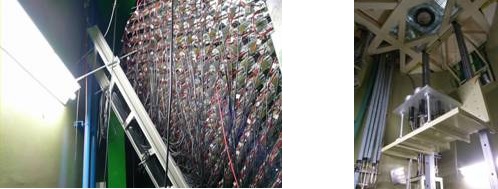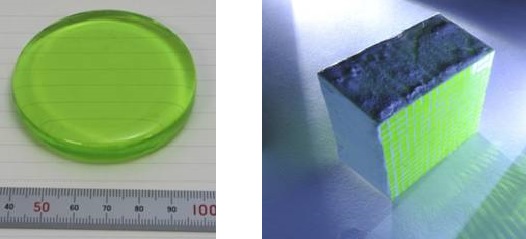Nuclear Science (NS)
Summary
The NS group works on instrument development and measurement of nuclear fusion plasma, mainly targeting neutrons and gamma rays generated from fusion plasma. In addition, the group also measures X-rays, electrons, positrons, ions, neutrons, and other particles which are generated during nuclear synthesis reactions: these reactions are initiated by irradiating substances with the LFEX or Gekko Exa-laser, and are used in experiments to simulate events which are only known to occur in space, such as supernova explosions.
Research topics
1.Development of neutron / gamma ray instruments
- Nuclear fusion neutron measurement
By using the large MANDALA neutron instrument, we can measure the spectra of neutrons generated from nuclear fusion plasma, in addition to the ion temperature and density. Continuous improvement of the equipment is one of the group’s main research priorities, and we are working to attain reliable measurements, even in the presence of high-intensity X-rays which are generated during high-speed ignition fusion. In recent years, a liquid scintillator has been developed and its effectiveness was demonstrated. Currently, we are working towards the development of a neutron measuring instrument using a liquid scintillator, which is also an important research theme.
Multi-channel neutron spectrometer MANDALA (left) and liquid scintillator neutron time-of-flight instrument (right)
- Low-energy neutron spectrum measurement
For fusion neutron scattering measurements and nuclear science experiments, measurement of neutrons with energies of 1 MeV or lower is an important research subject. Over the past few years, we have undertaken development a suitable instrument for these purposes, using a glass scintillator developed in a joint research project between Osaka University and Kumamoto University.
A newly developed lithium glass scintillator (left) and scintillator array (right)
- Gamma-ray spectrum instrument
Gamma spectrum measurements are an important topic for high-speed ignition fusion experiments and nuclear science experiments, and we are currently developing an instrument for this purpose.
2.Nuclear science research
Elements with atomic numbers larger than that of iron (atomic number 26) are believed to be synthesized via processes including the S-, R-, P-, and RP-process. Reproducing the conditions for elemental nucleosynthesis which would be found in outer space, i.e. at high temperature and in high radiation fields, is extremely challenging in a research setting, and the data on these processes to date has not been sufficient. However, by using the LFEX laser, it is possible to reproduce these element nucleosynthesis reactions on Earth. We have conducted element synthesis simulation studies in this area in which we used LFEX to generate high-flux neutrons and gamma-rays for a short period of time and from a micro space.
Members
| Mitsuo Nakai | Professor |
| Akifumi Yogo | Associate Professor |
| Yuki Abe | Specially Appointed Researcher |
